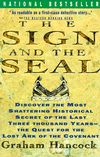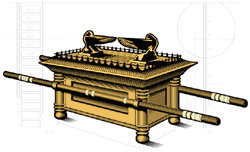The Ark of the Covenant, page 2
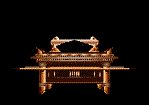
From our copy of Lost Secrets of the Sacred Ark, by Sir Laurence Gardner, we read that in 1904 Sir W.M. Flinders Petrie discovered something amazing on a wind-torn rocky plateau in the Sinai desert. It was the place described in the bible as Mount Horeb. and see this one.. Genesis 4
In the late 1890s, the British Egyptologist Sir William Flinders Petrie, a professor at the University College, London, applied to the Egypt Exploration Fund to take an expedition into Sinai. By January 1904, his team had departed and in the March of that year they took their expedition to the heights of Mount Serâbît. In the following year Petrie published the detailed results of his findings, but added to his report the fact that, to his dismay, this information would not be made available to the Egypt Exploration Fund subscribers who would receive only maps and a general outline. Furthermore, Petrie explained that, from the time of that Sinai expedition (even though he had taken previously funded teams into Egypt), his sponsorship by the Fund was terminated - ostensibly because he had broken the binding rule of the Articles by divulging something which was contrary to Bible teaching. He had, in fact, discovered the great secret of the sacred mountain of Moses - a secret which not only made sense of the Exodus portrayals, but which blew the lid totally from their common scriptural interpretation.
So, what precisely did they find high on the God's holy mountain? Well, to begin with, they found nothing very much. But on a wide plateau near the summit there were distinct signs of ancient habitation, and some pillars and standing-stones could be seen protruding above the ground-rubble. This rubble had been deposited, little by little, by wind and landslides over some 3,000 years. But when it was finally moved away, the truth of the Bible story emerged. Petrie wrote:
"There is no other such monument which makes us regret that it is not in better preservation. The whole of it was buried, and no one had any knowledge of it until we cleared the site."
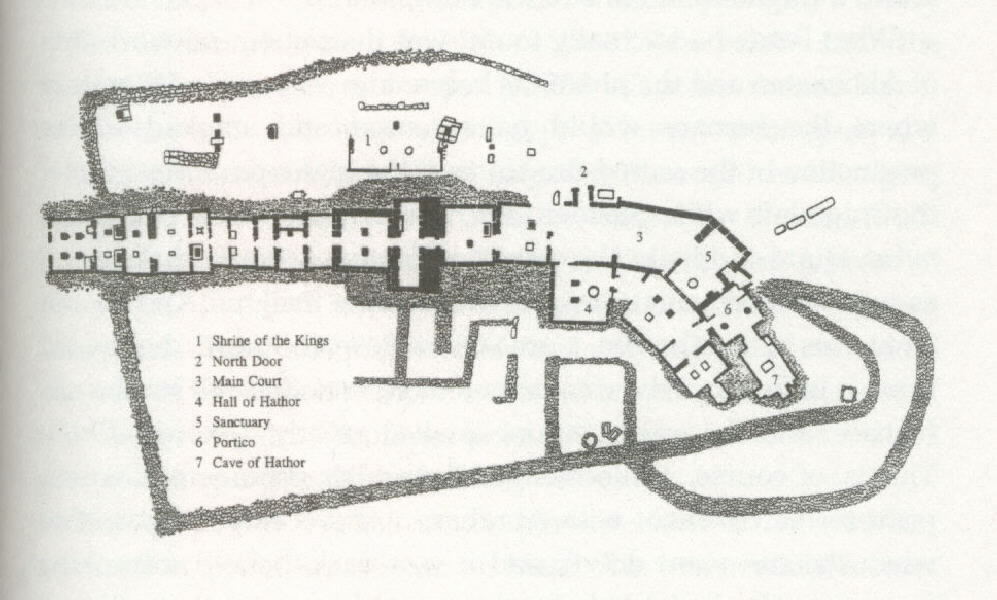 What they found was an enormous temple complex. Set within an
enclosure wall was an outer temple, built over an expanse of 230
feet (approx. 70 metres). This extended outwards from an inner
temple cut within a great cave in the mountainside. Dubbed as
Gebel Musa,( Mount of Moses ). It is 2,600 feet
above the Plain of Paran. Built over an expance of 230 feet,
extending from a great man made cave, they found the ruin of
an old temple. From the various cartouches, carvings and
inscriptions it emerged that the temple had been in use from as
far back as the time of Pharaoh Sneferu, who reigned about 2600
BC and whose immediate successors are reckoned to have built
the pyramids of Gizeh.
What they found was an enormous temple complex. Set within an
enclosure wall was an outer temple, built over an expanse of 230
feet (approx. 70 metres). This extended outwards from an inner
temple cut within a great cave in the mountainside. Dubbed as
Gebel Musa,( Mount of Moses ). It is 2,600 feet
above the Plain of Paran. Built over an expance of 230 feet,
extending from a great man made cave, they found the ruin of
an old temple. From the various cartouches, carvings and
inscriptions it emerged that the temple had been in use from as
far back as the time of Pharaoh Sneferu, who reigned about 2600
BC and whose immediate successors are reckoned to have built
the pyramids of Gizeh.
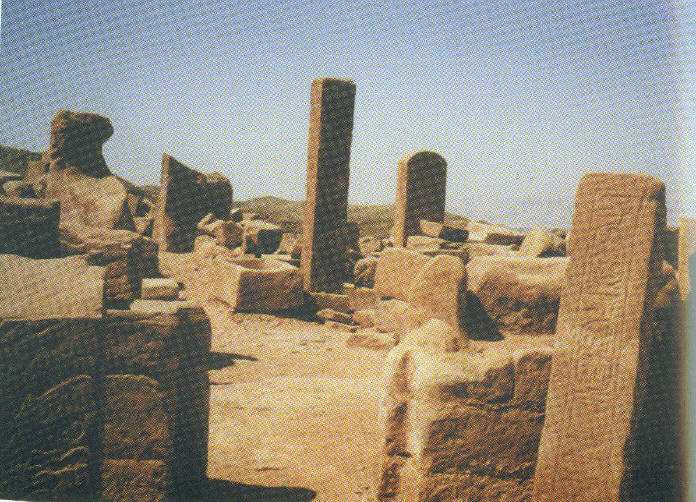 The above-ground part of the temple was constructed from
sandstone quarried from the mountain and it comprised a series
of adjoined halls, shrines, courts, cubicles and chambers. Of
these, the key features unearthed were the main Sanctuary, the
Shrine of Kings, the Portico Court, and the Hall of the goddess
Hathor (to whom the whole complex was dedicated).
The above-ground part of the temple was constructed from
sandstone quarried from the mountain and it comprised a series
of adjoined halls, shrines, courts, cubicles and chambers. Of
these, the key features unearthed were the main Sanctuary, the
Shrine of Kings, the Portico Court, and the Hall of the goddess
Hathor (to whom the whole complex was dedicated).
They found a Semitic altar stone and determined this to be a vast Egyptian Temple of 'some importance'. The artifacts were removed, deposited here and there until few remained to be researched. The discovery was viewed with displeasure at the time because it contradicted the Exodus portrayal of the events on the holy mountain. The funding party also had an objective of 'elucidating or illustrating the Old Testament', and the discovery contravened this completely, on it's interpreted version.
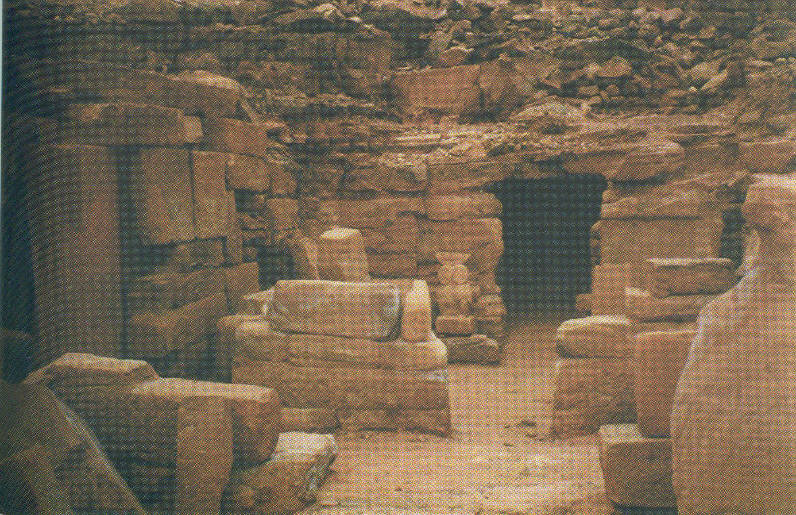 In short, this meant that if something was found which
could be used to support the scriptural teaching, then we (the
public) would be informed. Anything which did not support the
Church interpretation of the Bible was not destined to see the
light in the public domain.
In short, this meant that if something was found which
could be used to support the scriptural teaching, then we (the
public) would be informed. Anything which did not support the
Church interpretation of the Bible was not destined to see the
light in the public domain.
On one of the rock tablets near to the Mount Serâbît cave entrance is a representation of Tuthmosis IV in the presence of Hathor. Before him are two offering-stands topped with lotus flowers, and behind him is a man bearing a conical cake identified as white bread. Another relief details the mason Ankhib offering two conical bread-cakes of shem-an-na to the king, and there are similar portrayals elsewhere in the temple complex. One of the most significant perhaps is a depiction of Hathor and Pharaoh Amenhotep III. The goddess holds a necklace in one hand, while offering the emblem of life and dominion to the pharaoh with the other. Behind her is the treasurer Sobekhotep, who holds in readiness a conical cake of white bread. Most importantly in this portrayal, however, is the fact that Treasurer Sobekhotep is described as the 'Overseer of the secrets of the House of Gold, who brought the noble and precious stone to his majesty'.
463 items were removed. These included; large obelisks, and stelae to small wands and bowls. There are offering tables, statues, and an altar along with vases, amulets, plaques and tools. The various pharaonic cartouches and inscriptions denote an extended time frame from the 4th dynasty through the Middle Kingdom (with a particular emphasis on the 12th dynasty), the new Kingdom (especially the 18th dynasty time of Moses) to the Ramesside era, culminating with the 20th dynasty. This represents an operative use of the temple through about 1,500 years.
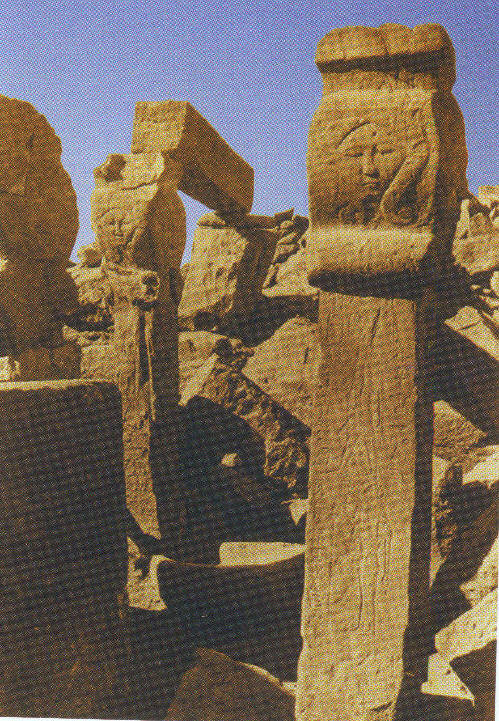 The temple was dedicated to the goddess Hathor throughout
its operative life. (look closely to see the face carved into the rock)
It appears to have ceased function
in the 12th century BC, when Egypt fell into financial decline
and to outside influences, leading to the Greek rule of
Ptolmemies. Deep within the cave Petrie found a limestone
stela of pharoah Rameses I, who had described himself as
"The ruler of all that Aten embraces". Also found was an
Amarna statue-head of Akhenaten's mother, Queen Tiye, with
her cartouche set in the crown. On a previous page we said
we thought Rameses secretly worshiped one god because a
statue of him found upside down and buried in the desert
sand depicted him on one side and Aten on the other.
The temple was dedicated to the goddess Hathor throughout
its operative life. (look closely to see the face carved into the rock)
It appears to have ceased function
in the 12th century BC, when Egypt fell into financial decline
and to outside influences, leading to the Greek rule of
Ptolmemies. Deep within the cave Petrie found a limestone
stela of pharoah Rameses I, who had described himself as
"The ruler of all that Aten embraces". Also found was an
Amarna statue-head of Akhenaten's mother, Queen Tiye, with
her cartouche set in the crown. On a previous page we said
we thought Rameses secretly worshiped one god because a
statue of him found upside down and buried in the desert
sand depicted him on one side and Aten on the other.
The real investigation came when they found two conical stones about 6 inches and 9 inches in height respectively,(seen below) and a metallurgist's crucible and a considerable amount of pure white powder concealed beneath carefully laid flagstones. This mysterious substance called mfkzt pronounced 'mufkuat', had dozens of mentions on the Serbit wall and stelae inscriptions. The word was researched in 1845 by German philologist Karl Richard Lepsius. It meant 'stone' but a stone that was extremely valuable and regarded as being in some way unstable. Eliminating all others, the stone became a mineral product. The pyramid texts describe the dead King Unas as living forever in the Field of Mfkzt.
The white powder and the Mfkzt were equally indefinable and yet both of great importance, maybe they were one and the same. But how can a powder be described as stone? The conical object was described as 'white bread'. Stelae detailed the mason Ankhib offering two conical bread-cakes to the king and there are similar portrayls elsewhere in the temple complex. The treasurer Sobekhotep, holds in readiness a conical loaf of 'white bread' and is described as 'the man who brought the noble Precious Stone to his majesty'. The treasurer was called "The Great One over the secrets of the House of Gold." The Temple was called 'The House of Gold'.
The ORME -- related to Star Fire and also known as The Philosopher’s Stone the Elixir of Life, the White Powder of Gold , Ma-na or Manna -- is also an acronym for “Orbitally Rearranged Monoatomic Elements”. The phrase was coined by David Radius Hudson who has done an enormous amount of research on the subject (of which he has in turn shared with thousands of others). The word ORME -- perhaps coincidentally, or perhaps not -- is the same as the Hebrew word which means: the “Tree of Life."
The ORME represents a huge subject area, involving state-of-the-art chemistry, physics, and physiology, interpretations of Sumerian Egyptian and other histories (the Anunnaki , Gods and Goddesses of the Ancient World, the Adams Family , “Prime Directive” Violations, Chronicles of Earth , etc), philosophy, Sacred Geometry the Tree of Life and Ha Qabala -- to name only the more obvious connections. In many respects, the ORME is the connecting link between all of these subjects -- as well as a whole list of other subjects not mentioned.
The Chemistry and Physics of Monoatomic Elements describes the characteristics of those elements which have come to be known as the “Precious Metals . These eight metals include: ruthenium, rhodium, palladium, and silver (known as the “light platinum group”), osmium, iridium, platinum, and gold (known as the “heavy platinum group”).
These eight Transition Group elements, can in a monoatomic, superdeformed, high spin, and low energy state, lose their chemical reactivity and metallic nature -- thereby resulting in a state of Superconductivity -- a resonant condition complete with Meissner magnetic field(s), Cooper Pairs, and electrons which have literally changed into light (i.e. photons). These precious metals have the unique ability to remain stable in the monoatomic form, which can then lead to effects ranging from Levitation (weight losses) to Zero-Point Energy applications to fundamental biological and/or human physiological effects.
Of particular importance is the fact that all of these precious metals have a strong affinity for and are almost always found in their natural state in combination with gold. Gold, in turn, has a history of being the most precious of all commodities -- a “spiritual tradition” which has survived countless generations!
“In the Ark of the Covenant was a pot of the Manna, and the stone through which God spoke to Moses. When Moses was up on Mount Sinai, he was smelting the Manna to the gold glass. Why do I say that? When you understand that in Old Kingdom Egypt these [hairy things over the eyes] were called bushes not eyelashes. These were bushes; check you're Egyptian literature. The burning bush was the enlightened Third Eye.”
“So, Moses on Mount Sinai, when he looked upon the burning bush... That was just a mistranslation. It was the third eye opening and God communicated to him through this stone. God didn't write on the stone. If he wrote on the stone, why would he put it in a box, seal it up and then let no one look at it? If God wrote on it, He would put it up on the wall where everybody could read it. When you realize that in Old Kingdom Egypt, on the holiest day in Old Kingdom of Egypt -- in the Sign of the Seal [by Graham Hancock] you read this -- they carried around an Ark on two poles, and in the Ark was a stone. Coincidentally what was in the Ark of the Covenant? A stone. The pot of Manna and the stone. The gold glass.”
“Around the Ark of the Covenant was the Meisner field. The strange thing about the Meisner field is that other Meisner fields that oscillate at the same frequency, can enter that field and not perturb it. So if you are a high priest, a Melchizedek priest, and you eat this Bread of the Presence of God every week, you are a light being, and you can enter into that field and approach the Ark of the Covenant and not perturb it because you're in resonance with it. But if you're an ordinary soldier or a person who thinks bad things, they have to tie a rope around your legs because as you approach it, it may have a flux collapse. Now if you can imagine several hundred thousand amps, and now you have voltage, it's like a bolt of lightning. It literally is energy of an unbelievable magnitude.”
As long as there is no voltage, you could touch it, you could feel it, it's hundreds of thousands of amps, but no tickle, no tingle, because there's no voltage. As long as you're in resonance with it, you can approach it, you can touch it, you can hold it, you can feel it; Nothing! But if you're not in resonance with it, and enter the field, and perturb the resonance, and there's a flux collapse, and now you've got voltage... It'll kill you.”
“Remember in the Bible that the Ark of the Covenant actually levitated and floated along, and actually carried some of the people who were carrying it. The only thing to do that's a superconductor.”
For example, the second chapter of the Book of Genesis (King James version), describes the creation of the heavens and the earth, its population with plants, animals, and herbs, the creation and installation of man in the Garden of Eden, and the appearance from out of the ground of the Tree of Life and the Tree of Knowledge of Good and Evil. The Bible then quickly informs us that thar’s gold in them thar hills! “And the gold of that land is good; there is bdellium and the onyx stone.” [Genesis 2-12]
On the scale of creating heaven, earth, Eden, mankind, and so forth, why is gold suddenly such a priority? If the science of the ORME is correct, gold, along with Rhodium and Iridium (and potentially the other precious metals) may in fact be the Tree of Life. [Note that in this connection Genesis 2:5 - 2:25 is considered to be from an earlier source than Genesis 1:1 - 2:4, and thus may be alluding to a deeper meaning.] Alchemy books talk about “the White Powder of Gold”, the Food of the Gods -- a substance derived from yellow gold, but which has been transformed into a white powder upon reaching its monoatomic state. This is the same form, and may be equivalent to the same process by which Hudson found all eight of the monoatomic precious metals.
For the alchemists, “The Master Work” was to prepare the Elixir of Life (bdellium?) and The Philosopher’s Stone (onyx stone?) -- or in more anecdotal, traditional terms, transmute lead into gold. [The latter is more likely a diversionary fabrication to mislead those with less lofty ambitions, and who have not been initiated into the Mystery.]
In the quest to accomplish this noble work, the alchemists of old taught that the key to success was to “divide, divide, divide...” The implication of this advice is that only in freeing the atoms of an element from the confines of its crystalline-like metallic structure of many atoms of the same or diverse elements, could one hope to achieve the alchemists’ esoteric goal. In effect, the alchemists were apparently attempting to reach the monoatomic form of the gold and the other precious elements -- even if they might not have described the process as such.
Hudson has also connected the ORME with the Hebrew tradition of the Ma-Na or Manna -- also thought to be the White Powder of Gold. Curiously, manna means literally: “What is it?” This phrase is found repeated over and over again in The Egyptian Book of the Dead, The Papyrus of Ani [1]. The historical and philosophical implications thus include the ORME as part of the Melchizedek priesthood and the metallurgical foundry at Qumrun, where the Essenes were located.
Other references include the mixture of the white powder of gold in water as being “that which issues from the mouth of the creator”, “the semen of the father in heaven”, and The Golden Tear from the Eye of Horus. Hudson believes that Moses knew the secrets of making the ORME, and that the Ark of the Covenant was merely a container for the ORME. As a volatile, superconducting, electrical device, the ORME’s presence within would explain the incredible properties of the Ark; from levitation to “blasts of heavenly displeasure.” Later in the Essene tradition, the white powder of gold began being referred to as the “teacher of righteousness”, something which was swallowed and taken internally.... taken from ORME
The Platinum Metals Review includes articles which discuss the treatment of cancers using platinum, iridium, and ruthenium. Apparently, the application of a platinum compound to an altered DNA state (as in the case of a cancer) will cause the DNA to relax and become corrected. It is known that both iridium and rhodium have anti-aging properties, that ruthenium and platinum compounds interact with DNA, and that gold and the precious metals can activate the endocrinal glandular system in a way that heightens awareness and aptitude to extraordinary levels.
The ancients from thousands of years ago knew of the superconducting effect of the precious metals on our consciousness -- what they referred to as the light body (the ka), and that both the physical body and the light body had to be fed. In so doing, we can also use the properties of the monoatomic elements to levitate, and quite possibly activate the body’s so-called “junk DNA”, along with the generally unused 90 to 95 % of the brain!
There is also evidence that the Hathor Temple on Mount Horeb in the Sinai Peninsula was involved in the construction of the pyramids. The furnace laboratories were not only used to provide food for the light-bodies of the pharaohs in the Star Fire tradition, but by use of the levitation potential, the massive blocks of the pyramids could be easily moved into place. For, in fact, the white powder is capable of bending space-time, providing for a gravitational attraction of less than zero, and of transposing its own weightlessness to a block of stone. Even more exotically, Gardner has noted that: “The once-sealed King’s Chamber [in the Great Pyramid of Giza] was, in fact, contrived as a superconductor, capable of transporting the pharaoh into another dimension of space-time through the Meissner Field (a body’s polar magnetic aura).”
The possible implications of the existence of the ORME -- adding the white powder
of gold (and other precious metals) to one’s “diet” -- is astounding. Based on the full range
of literature, Hudson believes a human ingesting the ORME in the correct manner
can fulfill all the dreams of the esoteric alchemists, i.e.:
· To have perfect telepathy,
· Be able to levitate and/or bilocate,
· Know good and evil when it’s in the room with you
(i.e. eat of the fruit of the Tree of Knowledge of Good and Evil),
· Project one’s thoughts into someone else’s mind,
· Heal by laying on of hands, and
· Cleanse or resurrect the dead within two or three days after they have died.
The latter comes from the traditions of the Anunnaki in raising their own from the dead (after their Descent into the Underworld ), as well as the gospels of Jesus Christ.
Before we get back to Sir William Flinders Petrie, and to understand the root significance of his discovery, it is worth making a necessary distinction between the Israelites and the Hebrews of the Mosaic era. At that time they were not one and the same, as Bible teaching seems to indicate. The Hebrews were the family and descendants of Abraham, and their place of residence was, in the main, Canaan (or Palestine). The Israelites, on the other hand, were the family and descendants of one of Abraham's grandsons, Jacob, whose name was changed to 'Israel'. It was Jacob's family alone who had moved into Egypt, and it was their descendants who eventually returned with Moses - to be reunited, after countless generations, with their fellow Hebrews.
The difference between the strains was, of course, that the Israelites had long been subjected to the laws and religions of Egypt and they knew very little about the customs of their cousins in Canaan. Through more than 400 years they had been in an environment with a whole pantheon of gods; and although they had developed a 'One God' concept within their own fraternity, that god was not the Jehovah of the Canaanite Hebrews.
The Israelites' god was a faceless entity whom they called, quite simply, 'the Lord'. In the Israelite language he was called 'Adon'. This is one of the reasons why the names 'Lord' and 'Jehovah' were always separately identified in early texts, although they were brought under the wrap of the single God in later times to suit the emergent Jewish and Christian faiths. To the Egyptians, the name of this Lord (Adon) was quite similar; they called him 'Aten'. From this derived the name of Pharaoh Akhenaten, meaning 'Servant of Aten'.
So, when Moses and the Israelites made their exodus into Sinai, they arrived not as worshippers of Jehovah but of Aten; and it was for this very reason that they were given a whole new set of laws and ordinances to bring them into line with the Hebrew culture of their prospective new homeland.
When Moses and the Israelites left the Nile Delta, their obvious route to Canaan (where they were eventually headed) would have been directly across the wilderness of northern Sinai. So, why did they push southward into the difficult high country to spend some time at the Horeb mountain of Serâbît? This was a question that had long puzzled Petrie and his team.
Petrie found no gold at the Serabit temple and there is no evidence that gold was ever mined in Sinai - but that does not prove that gold wasn't brought there. Gold is not a traditional product of Sinai, but there are important references to Sinai and gold in the Old Testament. One of the biblical accounts does associate its gold with a mysterious powder, and it also mentions water - not for washing the gold as such, but for its immersion.
While Moses was on the mountain, Exodus says the people took
their gold braclets and ear rings and Aaron melted them down
and made a gold calf for the people to worship.
Read Exodus 32:20; It says "And Moses took the calf which they
had made, and burnt it in the fire, and ground it to powder, and
strawed it upon the water, and made the children of Israel
drink of it". The calf was made of pure gold, 24 kt.
The thing Moses did is more of a ritual than a punishment. Aaron had melted the gold, but Moses 'fired' the gold. The Septuagint is more explicit in stating that Moses "consumed the gold with fire". To consume is to 'reduce to nothing or to tiny particles'. So here is an alchemical process which turns gold to powder. But this required an extremely hot or flash fire that resembled nothing less than a high voltage electrical flash. Where did the electrical flash come from?.... The Ark!
17th century writings of alchemist Eirenaeus Philalethes refer to processes concerning gold. He produced a work in 1667 entitled Secrets Revealed. He was revered by Issac Newton , Robert Boyle and Elias Ashmole who as we have learned, were Masons and were the great scientists of their time. In this treatise Eirenaeus discussed the Philosopher's stone which was commonly thought to transmute base metal into gold. He sat the record straight by making the point that Stone was of itself made of gold, and that the alchemical art was in prefecting this process. A Brief called Guide to the Clestial Ruby says; gold resists the action of fire as successfully as any stone. In species it is gold, more purer than the purest, it is fixed and incombustable like a stone, but its appearance is that of a very fine powder.
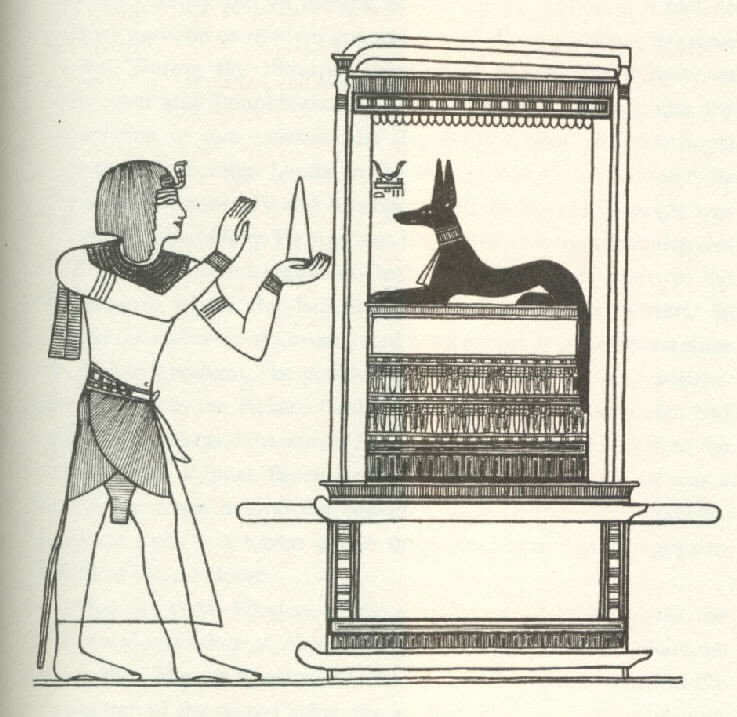 In his writing Eirenaeus described the gold as being
"digested", a word closely associated with "consumed"
(as in the Moses story). The Temple contained a ton of white
powder. The stelae to the right is inscribed, "The presenting of a
white bread that he may be given life". Another stelae shows
Amenhotep offering a conical load to the god Sopdu, and states;
"He gave the gold of reward; the mouths rejoiced". From these,
it is clarified that the white powder bread was preceived as a
giver of life, and that it was indeed made from gold. The gold
and the powder was also described in ancient Mesopotamia
and associated with a group of platinum and gold metals
and was called shem-an-na. This means the same as
mfkzt and it interupted as a 'highward fire-stone'.
In his writing Eirenaeus described the gold as being
"digested", a word closely associated with "consumed"
(as in the Moses story). The Temple contained a ton of white
powder. The stelae to the right is inscribed, "The presenting of a
white bread that he may be given life". Another stelae shows
Amenhotep offering a conical load to the god Sopdu, and states;
"He gave the gold of reward; the mouths rejoiced". From these,
it is clarified that the white powder bread was preceived as a
giver of life, and that it was indeed made from gold. The gold
and the powder was also described in ancient Mesopotamia
and associated with a group of platinum and gold metals
and was called shem-an-na. This means the same as
mfkzt and it interupted as a 'highward fire-stone'.
On our intro page we told you about David Hudson's accidental discovery in his own back yard. It was refered to as the 'white powder of projection'. In Arizona the soil has a high sodium content. It is crunchy and cannot be penetrated by water. To made the soil usable for farming it must be injected with high levels of sulfuric acid. They used 30 tons per acre. When analyzing the soil there were components that did not disolve with the acid. One component had an unusual quality. In the hot dry Arizona sun, ( about 115 degrees ), it flared into a great blaze of white light and disappeared. When the substance was dried slowly it proved to be iron, silica and aluminum. After removing the impurities, the substance produced a small glowing white bead. But it registered as pure nothing.
At England's Harwell Laboratory the substance was subjected to a neutron activation analysis using a spectroscopic arcing burn-time of 300 seconds. At 15 seconds the substance remained to be iron, silica and aluminum, and then it disappeared. But after continuing the burn time to 70 seconds at 5500 degrees, the substance reappeared registering palladium. Another 20 seconds it recorded platinum and after that came ruthenium, rhodium, iridium and osmium at 220 seconds. The tiny white bead was then composed of platinum group metals, which by Western testing standards registered as nothing. Over a cource of two and a half years, the tests continued and they came to the conclusion that the Phoenix farm of David Hudson had this metal at an astonishing rate of 2,400 ounces per ton.
Platinium group metals sell for $3000.00 per ounce, but the dissappearing act of the substances was more important at this point. David filed for patents ( 22 in all ) for the newly designated Orbitally Rearranged Monatomic Elements ( ORMEs). The substance was heated at 1.2 degrees C per minute, and cooled at 2 degrees C per minute. They found that when the material was oxidized, it rose to 102% of it's standard weight. The surprise came when the substance changed from it's original dullness to the familiar whitness of its bright bead and subsequent powder. At that moment the sample's weight fell to 56% of its starting weight. Where did the other 44% go? More tests continued until the sample while cooling weighed 400% of its starting weight. When heated again the sample weighed nothing - way below 0. When the sample was removed from the pan, the pan weighed more than it did with the material in it. It was perceived that the white sample had the ability to transfer its weightlessness to its supporting host. The pan was levitating.
Further heating at 1160 degrees C in a vacuum then transformed the precious substance into wonderfully clear glass, at which point the material returned to it's origional 100%. It was seemingly impossible, but it happened time after time again! This 'glass' has been described as being the substance of which the Emerald Tablet was made.
Technicians at the Varian Corporation in Califorina confided that if the weight loss were to occur on cooling, they figured the white powder was superconducting but, they said, " Insomuch as you are heating the material, we don't know what you've got here, or what's going on." However they were aware that high temperature superconductors had been discovered in 1986 at the IBM Research Laboratory in Zurich. Prior to this it was thought that they were only stable at extremely low temperatures achieved with the use of liquid helium. Lost Secrets of the Sacred Ark
An old Alexandrian alchemical text makes particular mention of the weight of the Philosophers' Stone - which it calls the Stone of Paradise. It states that: When placed in the scales, the stone can outweigh its quantity of gold; but when it is transposed to dust, even a feather will tip the scales against it.
In terms of a mathematical formula, this relationship is written as: 0 = (+1) + (-1). This appears to be a very straightforward sum at first glance, because (+1) + (-1) does indeed equal zero. But when applied to physical matter it is actually an impossibility because it relies upon using a 'positive' and an equivalent 'negative' to produce 'nothing'. The moment one has a positive piece of something, it is not possible to add an equivalent negative of that something to produce nothing. At best, one could move the 'positive' something out of immediate sight - but it would still exist, and it would therefore not be nothing.
The only way to turn something into nothing, as far as the material field is concerned, is to translate that something into another dimension so that it physically disappears from the mundane environment. If that process is achieved, then the proof of achievement would lie in the fact that its weight also disappears.
What, then, is it that can outweigh itself but can also underweigh itself and become nothing? What, then, is it that can be gold, but can be fired and transposed to dust? It is the phoenix - the red-gold that will fire to ashes but will then be restored to enlightenment. It is the golden calf that Moses burned to a powder. It is the highward fire-stone of the shem-an-na. And we know from the Sumerian records that this was not made of stone at all, but of shining metal.
In the alchemical tradition, the Philosophers' Stone is said to be that which translates base elements into gold. This is deemed to be the case in both the metallurgical sense and in the spiritual sense of higher enlightenment. In the physical sense, however, we must return to the oldest of all alchemical rules of the earliest mystery school: "To make gold, you must take gold."
David Hudson's story David Radius Hudson The real story of God and science.
![]()
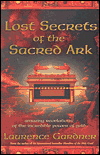 We also discover in the book that the Ark was indeed
already at the Temple and Moses knew it was there. He also knew
that Sinai was a safe haven and when the Israelites made their
exodus from the Egyptian Delta - a haven where there was an
operative Egyptian temple at Mount Horeb existed because
Akhenaten's decendent Panahesy, who was a Hyksos, was the
governor of Sinai. Thus before Akhenaten's era the Hyksos
and the Egyptians shared more than food.
We also discover in the book that the Ark was indeed
already at the Temple and Moses knew it was there. He also knew
that Sinai was a safe haven and when the Israelites made their
exodus from the Egyptian Delta - a haven where there was an
operative Egyptian temple at Mount Horeb existed because
Akhenaten's decendent Panahesy, who was a Hyksos, was the
governor of Sinai. Thus before Akhenaten's era the Hyksos
and the Egyptians shared more than food.
What the Bible does not make clear is that Sinai was not a foreign land to the Egyptians. It was actually regarded as a part of Egypt and came under Pharaonic control. So Moses and the Israelites had not left Egypt once they were east of the Nile Delta; they were still in Egypt, having the whole Sinai Peninsula to cross before they entered the Palestinian land of Canaan.
During the time of Moses, Sinai came under the control of two Egyptian officials: the Royal Chancellor and the Royal Messenger. This was the era of Egypt's 18th Dynasty - the dynasty of the Tuthmosis and Amenhotep Pharaohs, along with Akhenaten and Tutankhamun. The Royal Messenger of those times was Neby, an official who was also the mayor and troop commander of Zaru in the Nile Delta region of Goshen, where the Israelites had lived before the exodus.
The position of Royal Chancellor was hereditary in the Hyksos family of Pa-Nehas, and Panahesy of this family was the official Governor of Sinai. We know him better from the Bible as Phinehas. He became one of the first priests of the new Mosaic structure, but previously he had been the Chief Priest at Pharaoh Akhenaten's temple at Amarna.
The writers of Lost Secrets of the Sacred Ark place the exodus in 1300 BC, much later than we surmised but the Temple was there in 2500 BC and so was the Ark.
This all comes together in Job 28:5 - 6. According to
Qabalistic doctrine, the whole mystery of the cheubim rests
upon an understanding of alchemical principles as described
in the Hermetic text. It brings together the fire, bread,
stone, sapphire, and gold. "As for the earth, out of it cometh
bread; and under it is turned up as it were fire. The stones of
it are the place of sapphires; and it hath dust of gold."
We will add more but for the reason the gold or powder was
'Food for the Gods' and did infact give them an extended life,
you will have to read the book.
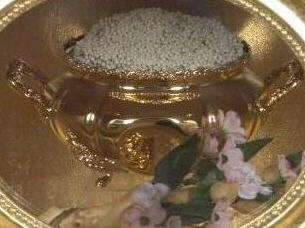 "Upon this table were placed twelve cakes of fine flour,
( or fine powder ) in two rows, six in a row, called "Shewbread."
"And thou shall set upon the table Shewbread before me alway."
Exodus 25: 30.
"Upon this table were placed twelve cakes of fine flour,
( or fine powder ) in two rows, six in a row, called "Shewbread."
"And thou shall set upon the table Shewbread before me alway."
Exodus 25: 30.
![]()
The Tablets of the Law
The fire on the mountain was the energy the ark gave off as some sort of laser was used to cut them. The Shimar as we described above -( The ruby and the silver plate wrapped around it.) The Talmudic-Midrashic sources say the Tablets were made of a sapphire-like stone; they were not more than six hands in length and as much in width, but were enormously heavy. They were hard but flexable and they were transparent. This same substance is said to be what the Tablets of Thoth are made of. The stone was described as being that of a meterorite.
The stone tablets had a strange pictographic alphabet. Archaeologists have determined this writing belonged to a semitic-Canaanite language related to ancient Hebrew.
The KJ bible says the first set of stone tablets were broken at the foot of the mountain by Moses when he discovered the people worshiping the golden calf. If these tablets were God's words , they would have been the most precious gift ever entrusted to man. So why did Moses break them in a rage?
Moses had spoken to Yahweh ( KJB version ) many times and no mention is made of his face shining. Why was this edited out? This included the visit to the 'burning bush' and the meeting they had in the 'tent'. Could it be that the first set of tablets were somehow different? Imperfect? Not made with the energy source as was the second set?
We found out why he broke them. see Moses see the paragraph on Essene teachings.
We have already covered the fact that Moses knew God's Laws, but it wasn't the God, Yahweh who taught him the Law. It was Ra, Thoth, Maat and Isis, but YHWH is Ra and all the others were discarded when Moses left Egypt, so they say.
...Moses then was commanded by God to return to the mountain where he stayed for fourty days. The biblical passages describing the second decent from the mountain are quite different from the first one. Moses' skin 'shone'.
Exodus 34 describes his appearance as the people being afraid to come 'nigh him'. He put a veil over his face and ever afterwards, except when he was alone in the tent, he wore this veil. Moses was indeed burned very badly. God would not have done this, but radiation would have.
![]()
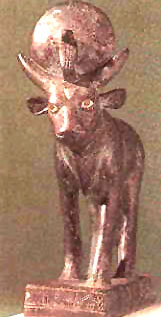 "The Apis bull, as
depicted in this Egyptian statuette, is likely to be the pattern
used for the golden calf the Israelites made at Mount Sinai
(Exo. 32), since they were undoubtedly quite familiar
with it as a result of their long captivity in Egypt. Note that
in front of the sun disk and horns, which looks virtually
identical to some Catholic monstrances, there is the serpent
poised to strike. In Scripture the serpent is symbolic of Satan.
(Gen 3, Rev. 12:9) But it is also a symbol of 'light' or
knowledge. If we consider how the Romans discredited knowledge
as evil, we understand how the 'dark ages' came about.
"The Apis bull, as
depicted in this Egyptian statuette, is likely to be the pattern
used for the golden calf the Israelites made at Mount Sinai
(Exo. 32), since they were undoubtedly quite familiar
with it as a result of their long captivity in Egypt. Note that
in front of the sun disk and horns, which looks virtually
identical to some Catholic monstrances, there is the serpent
poised to strike. In Scripture the serpent is symbolic of Satan.
(Gen 3, Rev. 12:9) But it is also a symbol of 'light' or
knowledge. If we consider how the Romans discredited knowledge
as evil, we understand how the 'dark ages' came about.
The Apis bull is identified with Osiris as "Bull of the
West". The bull was thought to be the animated by the soul of
Osiris. The appearance of a new Apis was regarded as a new
manifestation of Osiris upon earth; but he was also an emanation
of Ptah, and he was called the son of Ptah. The double god,
Asar-Hapi or Hapi-Asar is depicted in the form of a bull,
which has the solar disk and a uraeus between its horns.
E.A.Budge, Gods of the Egyptians
Worship of the bull goes all the way back to Ptolemy who
had a dream about this statue. The staute was at Sinope. They
found it there and Ptolemy ordered it brought to Alexandria.
They concluded that the bull represented Pluto and was the
same as the Egyptian Sarapis which was also Osiris.
Sarapis, in the proper meaning of the word, signifies him who
disposed the Universe into its present beautiful order.
The priests indeed, at least the greatest part of them, tell
us that Sarapis is none other than the mere union of Apis and
Osiris into one word; declarative as it were that opinion
which they are perpetually explaining and indicating, 'that
the Apis ought to be regarded by us, as a fair and beautiful
image of the soul of Osiris.'
If the Hebrews were worshiping the bull as Osiris, this
would have made Moses very angry as he was trying to get them to
believe in One God, who at that time would have been Aten.
In the Desert, when the people made the golden calf, 3000 Israelites were killed by the new Hebrew priests as so commanded by 'God'. The bible indicates the ignorance of the people was overwhelming. But considering their long life in Egypt and the familarity they had with Osiris and the others, this is not surprising. They steadfastly resisted Moses' efforts to turn and their belief to 'One God'. This was never excepted fully no matter what Moses or Aaron did to convince them. Only the 'initiates' and true 'Sons of Light' believed Moses.
When the congregation of Israel assembled for instruction,
musical praise with instruments was forbidden by the Law of Moses.
God gave this law as the result of their rising up to play at
Mount Sinai as they worshipped the golden calf with singing,
dancing naked and playing musical instruments.
Speaking of the hymn after crossing the Red Sea, Smith's
Bible Dictionary says that: The triumphal hymn of Moses had
unquestionably a religious character about it; but the employment
of music in religious services, though idolatrous, is more
distinctly marked in the festivities which attended the erection
of the golden calf."
The Golden calf was erected by the Israelites on several occasions, as related in the Bible and the Qur'an. Aaron made one while Moses was on Mt. Sinai. Jeroboam placed one at Bethel and another at Dan. Hosea denounced one in Samaria. Archaeological evidence from Palestine suggests that bull images functioned as representations of the gods or as bearers of them. Bull cults were widespread in Canaan at the time of the invasion of the Israelites. When the city of Nineveh was excuvated, they found over 100 images of lions and calves buried in an underground chamber.
When the Israelites made their bull or cow image at Mount Sinai, they played a game. Aaron told the people: "This is the God Who brought you out of Egypt." Later in Palestine, the Israelites claimed that the cattle images were really just a place upon which Yahweh could land and rest. Modern dance teams claim that they provide the same place for God to make a landing in their midst
Most writers have accepted the view of Philo and the early Fathers, who regarded the worship of the golden calves as borrowed from the Egyptians, and in favour of this opinion is the fact that both Aaron and Jeroboam had sojourned in Egypt shortly before constructing their respective idols; this view, however, has its difficulties, among which is the improbability of an Egyptian deity being set up as the god "who brought Israel out of the land of Egypt". Hence, some recent scholars are inclined to seek the origin of the Hebrew bull worship in the conditions and surroundings of the Israelites as an agricultural people, for whom the bull was naturally an appropriate symbol of strength and vital energy.
It has always been Israel's fate to mix the One True
YHWH with pagan deities:
"Hathor, the Mother aspect of the
triple-goddess Isis, was depicted with a cow's head, and so was
Mary, because "Mary" is also one of the three faces of
Isis, one of the Egyptian "Meris" or "Maris." Again, Meri/Mary
represents the Mother aspect of Isis. She is also the Queen of
Heaven and the Goddess of the Sea, as "mar" or "mer" refers in
many languages to the ocean or sea.
As we mentioned earlier on a previous page, We believe Jesus, accompanied by John the Baptist was in the Temple ( The Pyramid ). Therefore God choses who will be allowed to be in his 'Sacred Knowledge Room' and what skills will be needed for the purpose at hand.
On another page we mention the 'Test". Jesus took this test in the pyramid. It involved the practice of alchemy. If you look for the link to this secret page, you'll find it. Hint - Jesus series.
If you saw the Movie, 'The Fifth Element', this all comes together. The 'Son' is always the Fifth Element combined with Air, Fire Water and Earth and the 'Son'( light), anything is possible. If you can except this, then the rest of the story will make sence and not sound like God didn't have something to do with it.. He did, just not directly. Call this new age thinking, but it fits all the information together with what scholars, scientists scrolls, ect., have uncovered about Moses.
In Plato's Timaeus, the elements became a shape in the form of the five bodies. In dutch they are called: de vijf regelmatige veelvlakken. I cannot translate that into english, but they are also called Platonic bodies. You first see fire which forms the primaire antithesis with earth. Then we see air, without which fire can not exist, and water which forms the liquid part of earth, and without which no life could be possible on earth. Then we see the fifth element, which should according to Plato be in the centre of the elements, and which is called the Quintensens, of which all other elements are created, and which is the symbol of the entire creation.
If you read the extensive way with which Plato explained the other elemental bodies you cannot but wonder why there is only one line about the fifth body.. the quintensens or to put it more mathematical: the dodecahedron. The solution is, that the dodecahedron was not made public. Also in the middle Ages and Renaissance the knowledge of the dodecahedron, and with it the connection of the pentagam was passed on only to the most prominent architect and his closest collegues. Furthermore they had discovered that the dodecahedron, through connecting certain edges etc. held in itself all other bodies. The dodecahedron became thus the basis for obtaining all other bodies and was not without reason for Plato the symbol of the all all-embracing Universe.
Any look at the meaning of the pentagram would be incomplete without first looking further at the meaning of the 5 elements. In western thought these elements consist of Earth, Air, Fire, Water and Spirit (Ether). Ether is probably the most obscure of the elements. The idea of Ether comes originally from early Alchemy. Einstein provides a very eloquent discription of the principal of Ether and it's connection to relativity, but actually Newton was not the originator of the theory, as Einstein suggests. In fact Pythagoras was the first Western figure credited with the specific mention of a fifth element which he titled 'Aether' (or 'Aither'). Pythagoras also borrowed from the teachings of the philosopher Empedocles who had first posited the existence of 4 basic elements which he corresponded with 4 of the Greek Gods (book 1.33). From..Pythagoras
![]()
As we have established in , Goddess worship , According to the KJB, King Solomon became corrupt. He began worshiping 'other gods', namely Astarte, the Goddess of the Sidonians. Solomon had hundreds of wives who were followers of this goddess and the KJB says they led him away from Yahwah. Solomon never really thought of Yahwah as the true, one and only God. Did he know something we didn't know? "He never stopped worshiping Astarte". This tells us that Solomon knew the true God who we feel isn't Yahwah.
There are Hebrew inscriptions invoking a blessing by Yahwah and by his asherah, the wooden image of a goddess, a female consort for Yahwah himself. Having Yahwah rule alone was the view of only one group in Israel. The temple was desecrated by the priests and no Hebrew prophet or initiate cared a straw about it. The Initiates did hold to the 'secret doctrine' of Moses, but the common people stayed with their idolatry exactly the same way as the Pagans. Was this Yahwah?
One of Solomon's wives, who was the Queen of Sheba, and who's origional home land would have been south-west of Arabia, had a son named Menelik. Some believe she was Ethiopian. Menelik grew up in Ethipia, but at the age of 20 he traveled to Isreal to be recognized by the elders and accorded great honor by the king's court. After a year had passed, the elders became jealous of him and complained that the king had showed him too much favour and they insisted he go back to Ethiopia. This the king agreed to, but only if the first born sons of all the elders would go with him. One young man was Azarius, son of the High Priest of Israel.
The Jewish blood lines of Solomon turned up in Ethiopa thru Menelik I, Yekuno Amlak and a young prince named Lalibela. Laliblea built eleven spectacular monolithic churches, one of which was named after the church in Jerusalem, the Church of the Holy Sepulchre. He also named a river running through the town , 'Jordan'.
Where is the Ark?
The story told by the supposed 'guardian monk' of the temple at Axum in Ethiopia, is that Azarius had taken the Ark out of Israel because 'it was Gods will' and did not tell Menelik until they were safely far away from the city. The monks of Axum claim to have the origional ark, but no one except the High Priest is allowed to be in the same room with the relic.
According to an article in Canada's "Sunday Sun" newspaper by journalist Kaye Corbett, a three-year search has positively located "the most important archaeological, historical and religious object in man's history" buried in the bowels of the Ethiopian Orthodox St. Mary of Zion Church in Aksum -- a holy city 623 km. north of Addis Ababa.
Corbett promises to reveal his findings in a soon-to-be-published book co-authored with H.R.H. Stephen Mengesha, a great grandson of Emperor Haile Selassie. He writes that the Jewish State of Israel will soon make a claim on this most valued relic, prior to building a new Temple to house the Ark on Temple Mount in Jerusalem -- the controversial site presently occupied by the Muslim's Dome of the Rock shrine. Corbett states that such a claim would have a dramatic effect on the Jewish state and the world.
That is putting it mildly. The effect of any attempt to relocate the Ark of the Covenant may well be the Third World War.
There is in the Legend of Hiram Abiff, reference to the sprig of Acadia placed over the spot were the ruffians buried Hiram and then they were going to escape to Ethiopia across the Red Sea. ( They didn't get away however as they were captured by fifteen Fellow Crafts sent by Solomon to find Hiram .) This cannot be coincidence, since the Ark is made from Acadia wood and here is a monk telling a very informed investigator, the Ark is indeed in the temple at Axum.
Further coincidence is that Hiram built a 'sea cast of metal', ten cubits from rim to rim. This measured fifteen feet in diameter and seven and a half feet high. It would have held about ten thousand gallons of water. The sea seemed to represent ancient Egyptian rituals werein an Ark was carried to water. In Ethopia today at the festival at Timkat in Gondar, the tabotat is carried to the edge of a 'sacred lake' at the rear of the castle.. So it seems the bronze sea was also a sacred lake.
Jewish legend has it that moments before the Babylonians burst into the temple, the sacred relic had been hidden away, placed in a sealed and secret cavern directly beneath the Shetiyyah ( foundation ), which was the floor of the temple.
2 Kings 19:15 states that King Hezekiah ( 12th lineal descendent of Solomon )of Judah was said to have prayed before the ark. In the subsequent reigns of Kings Manasseh and Amon, the ark was removed to a Levite sancturary while there was a danger of war and conflict within the temple. 2 Cronicles 35:3 Josiah, King of Judah, decided that the ark should be returned to it's proper abode. "He said unto the Levites that taught Israel, which were holy unto the Lord, Put the holy ark in the house which Solomon the son of David king of Israel did build: it shall not be a burden upon your shoulders." This was 360 years after Solomon built the temple and shortly before the first invasion of Jerusalem by Nebuchadnezzar which occured around 597 BC.
In Maccabees 2:1, 4 - 5, "The prophet Jeremiah, warned by an oracle, gave instructions for the tabernacle and the ark to go with him when he set out for the mountain which Moses had climbed to servey God's heritage. On his arrival Jeremiah found a cave dwelling into which he brought the tabernacle, the Ark and the altar of incense, afterwards blocking up the entrance". This story has never held much value with scholars, who say, "It's nothing more than an inspirational fable devised by the author of the second book of Maccabees, who was trying to reawaken interest in the national homeland to expatriate Jews." With the excavations of Petri in 1904, we find the ark was not found on the mountain, but there was a temple there.
In the inventories of the plunder taken by Nebuchadnezzar given in 2 Kings 25:13-17 and Jeremiah 52:17-23, there is no reference to the ark. Jeremiah 3:16 states, "The ark of the covenant of the Lord: neither shall it come to mind: neither shall they remember it: neither shall they visit it.
Chronicles 6:1 says, that the Lord would dwell in the thick darkness and in Revelation 11:19, there is confirmation that the ark was still in the Temple of Heaven. In the Mishneh Tarah of 1180, the Spanish philosopher Moses Maimondes told that Solomon had constructed a special hiding place for the Ark deep beyond winding tunnels - the same crypt which had been used by his son Rehoboam when Shishak of Egypt invaded. In 1648, Rabbi Naftail Hertz says in his "Valley of the Kings", how the holy relic had been safely stowed before the temple was destroyed. Does this mean it's back in Egypt?
Ron Wyatt says he's found the Ark. see..
see The Ark of the Covenant
In the Apocryphal book of 2 Maccabees, we read: 2:2 The records show that it
was Jeremiah who... 4 .... prompted by a divine message, the prophet gave orders
that the Tent of Meeting and the Ark should go with him. Then he went to the
mountain from the top of which Moses saw God's promised land 5 When he
reached the mountain, Jeremiah found a cave-dwelling; he carried the tent,
the Ark, and the incense altar into it, then blocked up the entrance. 6 Some
of his companions came to mark out the way, but were unable to find it. 7 When
Jeremiah learned of this he reprimanded them. 'The place shall remain unknown
' he said' 'until God finally gathers His people together and shows mercy to them.
8 Then the Lord will bring these things to light again, and the glory of the Lord
will appear with the cloud' as it was seen both in the time of Moses, and when
Solomon prayed that the shrine might be worthily consecrated. The writer, in
this letter to "Jewish kinsmen in Egypt, the Jews who are in Jerusalem, and
those in the country of Judaea", explains where he got this information:
"These same facts are set out in the official records and in the
memoirs of Nehemiah Just as Nehemiah collected the chronicles of
the kings, the writings of prophets, the works of David, and royal letters
about sacred offerings, to found his library, so Judas also has collected
all the books that had been scattered as a result of our recent conflict.
These are in our possession, and if you need any of them, send messengers for them."
The quote in 2 Maccabees, above, could have been mis-translated over the years and originally have stated that the Ark was hidden NOT in the mountain Moses was ON when he viewed the promised land (Mt. Nebo, Deu. 32:49), but instead it could mean that the Ark was hidden IN the mountain that Moses SAW when he viewed the promised land. From Nebo he would have been able to see Jerusalem because of it's altitude.
The Templars and the Ark
The records of a temple guard, here described as the Knights of St Andrew, apparently had records from a guard unit called Hilkiah's Temple Guard, dating back to 1700 years before them. The records apparently had been removed from the temple by Jeremiah. They were also called the Guardian Princes of the Royal Secret; the inheritors of an order established by Hilkiah the High Priest. French Templar chronicles of the Middle Ages confirm that the catalogued treasure became the responsibility of this order of Templars. Book 2 Chronicles 5:9, complied between 300 and 250 BC, which was after the second temple was built, states in respect to the ark, "There it is unto this day."
The Templars, Hugh de Payens and The Count of Champagne had made a visit to the temple in 1104 and returned to France and were known to still be together in 1113. Hugh returned to the Holy Land alone in 1116 and again in 1119 with the eight other knights who formed the nucleus of the Templar order.
Saint Bernard of Clairvaux, a nephew of one of the founding knights apparently had something to do with the mission as did Andre'de Montbard, Bernards uncle. It was Bernard who drew up the formal rule of the order of the Knights Templar. He also gained official church recognition for the 'Order of the Poor Knights of Christ and the Temple of Solomon'. Their secret mission while staying at the Temple of Solomon was to locate the Ark and remove it. They are said to have found it and taken it to Scotland where their order was safe from prosecution.
If indeed the Templars found the Ark, it is no surprise that they found a way to smuggle it out of Jerusalem and take it to a safer location, because in the eleventh century people were obsessed with finding religious relics and the Ark would have been the ultimate prize. Since ancient times, the messianic movement had learned to 'keep secrets' so they wouldn't have advertized their find under any circumstances. Read more about the Knights here.. The Knights Templar
There is yet another theory, that the Ark remains under the origional Temple buried some 48 feet under the surface. There is a tunnel under the 'Wailing Wall', but this tunnel is under Muslim control Rabbi Shiomon Goren and Yehuda Getz have stated in a letter to a TV viewer that, 'I can confirm that I do know the exact location of the Ark', however he would not comment further saying the information needed to be kept from the public until the proper time.
Vendyl Jones, who inspired the creation of 'Indiana Jones' and the Steven Spielburg movie, says he too found the Ark. According to Jones, there is a mini temple on a small scale of Solomon's temple in the city of Gilgal. This place served as a base of attack of Joshua on Jericho. There is a wall 50 meters high and 11 meters wide and is the ritual wall of the tabernacle. The altar was here where the Ark was placed.
Sylvia Brown, renouned psyhic, says the Ark is under the Sphinx in Egypt.
![]()
There is yet another description of the Ark. It seems to be a Nuclear-powered machine capable of producing 'Food'. It also is said," It was a thing, they called the Grail, that gave all eathly desires in abundance."
 Hebrews 9:4 describes the ark containing the "gold jar of
Manna". The Ark , according to the Kabbalah( Jewish
traditional knowledge ) contains this magical, possibly
extraterrestrial machine. The Zohar( a book of the
Kabbalah ) speeks of the manna as the food of "the just ones of
the world to come."
Hebrews 9:4 describes the ark containing the "gold jar of
Manna". The Ark , according to the Kabbalah( Jewish
traditional knowledge ) contains this magical, possibly
extraterrestrial machine. The Zohar( a book of the
Kabbalah ) speeks of the manna as the food of "the just ones of
the world to come."
Since we have discovered what the 'Manna' was we might now have a better understanding of what the machine was.
There exists an epic called The Parsifal which was written on 1200 AD by poets named Robert de Boron and Chertien de Troys. Also the German story teller Wolfram von Eschenbach, who wrote that, "once upon a time it brought a troop, which flew back to the high stars, because their innocence drew them homewards.". In the epic of the poets, a young hero who is the Knight, Sir Lancelot, meets King Arthur. He travels to a castle called Munsalvatsch and there finds a clan of nobles called 'Guardians of the Grail'. The Ark machine is also called 'the grail' and describes it as a 'handsome vessel' or a 'metal bowl'.
From the Zohar there is the description, "and from the dew they grind the manna of the just ones for the world to come. At that time the Ancient of Days fed them from that place."
Also:"See, I will make bread from Heaven to rain upon ye." and further; " God gave thee of the dew of Heaven."
![]()
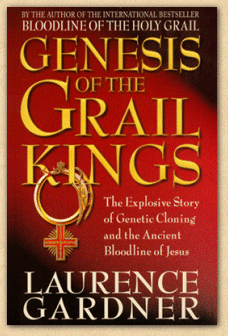 |
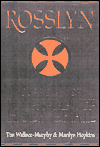 |
 |
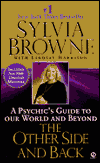
|

|
 |
 |
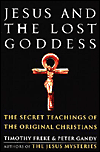 |
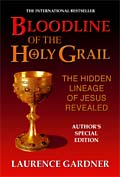 |
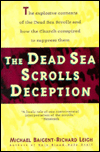 |
 |
Search this site
Our search Engine does not search for the links in this site, only words in the text.
NO PART OF THIS SITE MAY BE COPIED OR REPRODUCED, IN WHOLE OR IN PART
WITHOUT THE EXPRESS WRITTEN APPROVAL OF THE WEBMASTER.
© COPYRIGHT 1999 - 2010 C.I.Case...ALL RIGHTS RESERVED.
If your site is not Masonic in nature, we kindly ask that you do not link
here without permission or under the guidelines set forth here.
..
see Legal Issues
This page has been visited Times since September, 14th, 1999
